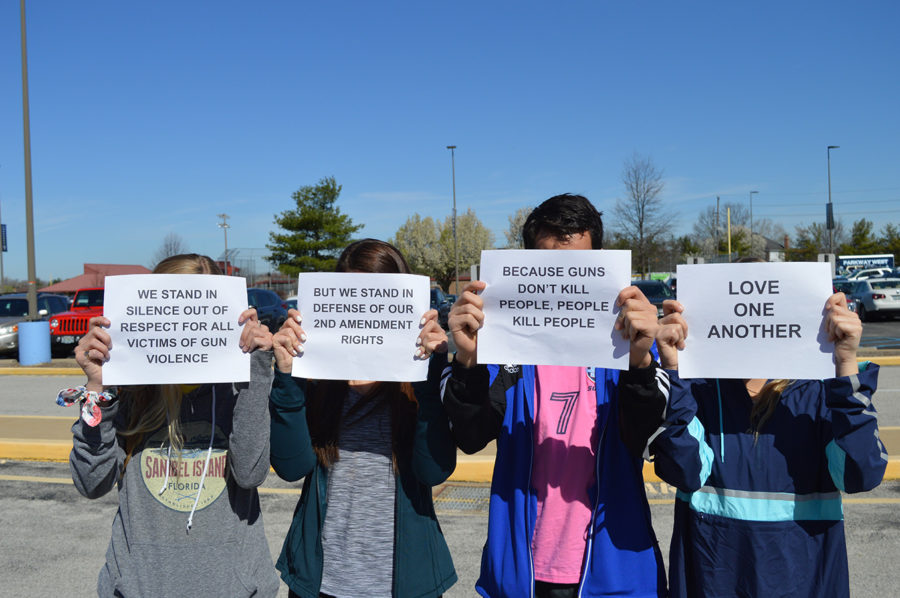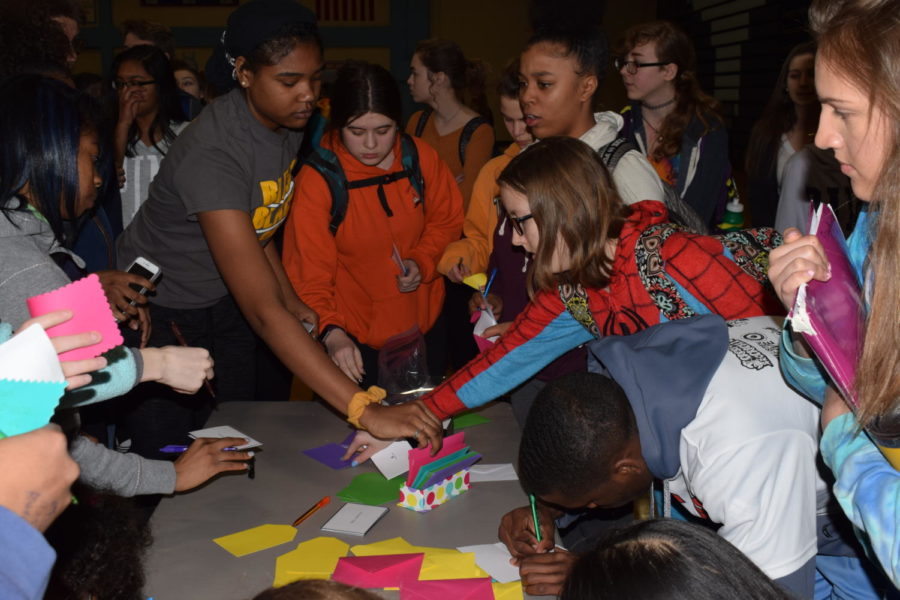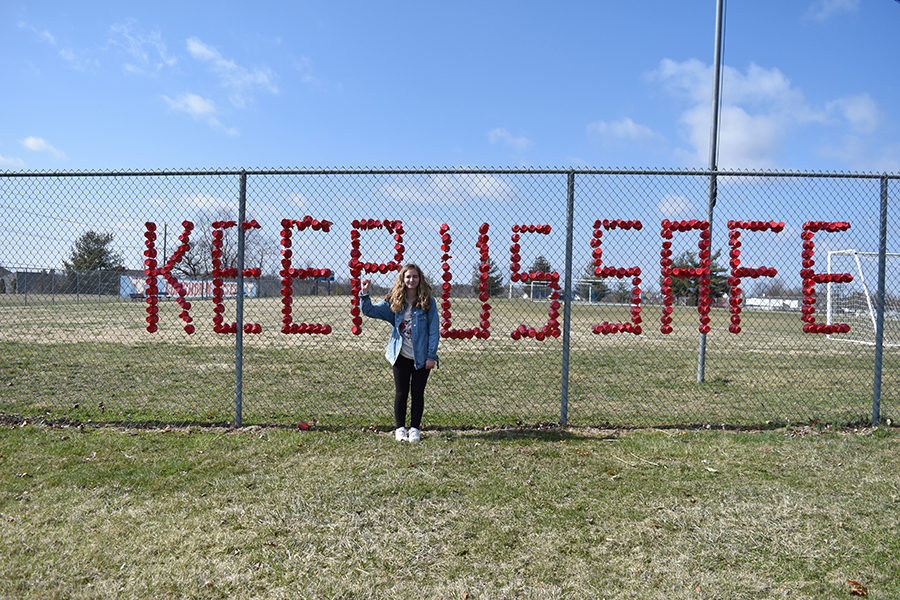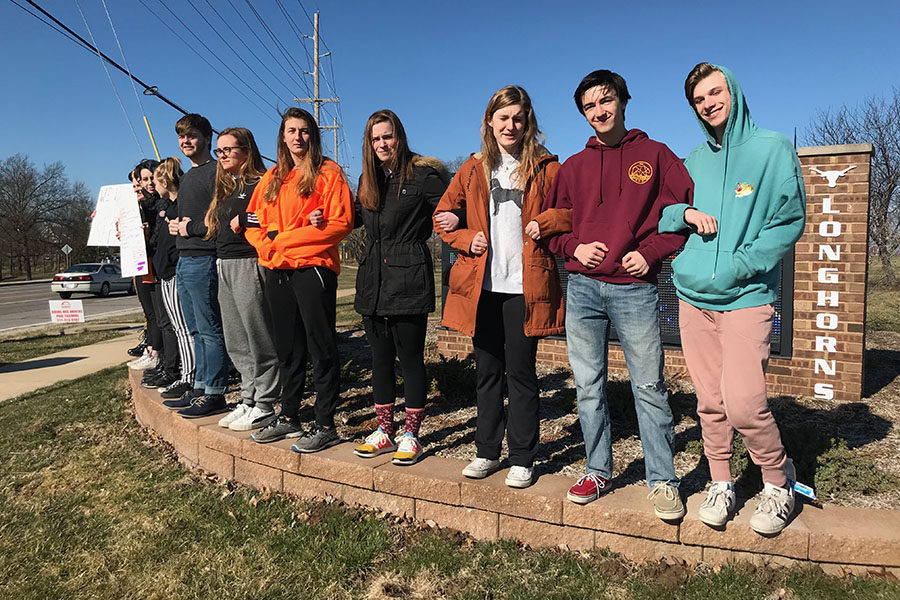Students and teachers discuss gun regulation in light of school shootings
April 1, 2018
Through walkouts and political advocacy, students at West aim to spread awareness and encourage legislation limiting access to guns after recent school shootings.
Students protest against gun control
While recent walkouts and protests against gun laws in our community continue to raise media coverage, there is a side to the story that has not been widely shared: those who advocate against gun control rather than in favor of increased security measures.
Students empathize with victims of school shootings and stand against gun violence, but they stand firm in their beliefs regarding second amendment rights.
“I don’t think we should have gun control because guns have always been available to us by our second amendment rights,” sophomore Grace Kroner said. “They protect a lot of people and our military uses them to protect our country and there’s no reason why we should have them taken away.”
Students like Kroner disagree with the March 14 and April 20 walkout and feel that the protest was falsely advertised.
“The walkout was promoted as being a silent 17 minutes to pay tribute to the victims, but instead they made speeches and there was a lot of yelling, and I don’t think that’s the right way to respect the people that died,” Kroner said. “If it had been quiet, I would’ve gone, but I heard that there were going to be speeches and I knew that the speakers would push their ideology on everyone and I didn’t want to participate in that because it’s not right.”
Advocates for constitutional rights disagree with the desire to tighten gun control because they feel that increased gun laws would jeopardize their ability to defend themselves.
“I’m a big believer in the second amendment and I advocate for not only self-defense, but for utilities that you can use a firearm for such as hunting and recreational use, but especially self-defense,” senior Andrew Wachter said. “In the event of an emergency, it’s nice to have those things. You can’t always rely on the police and people to do things for you when you can do it yourself.”
Wachter was one of four students to participate in a silent protest against gun control at the March 14 walkout. The students stood outside of the main gym silently holding signs expressing their opinions on guns in the United States.
“I know that I’m one of the minority, and it is unfortunate, but it’s all the more reason to be strong and firm in my beliefs and stand my ground,” Wachter said. “During the walkout, we had a lot of weird looks. We had one student yelling profanities at us, and she was taken aside and talked to.”
Wachter attributes the rise in school shootings to what he considers modern society’s shifting values.
“I think shootings are a societal thing, if not a mental awareness thing,” Wachter said. “Back in the 40’s and 50’s people came to school with their hunting rifles in the back of their trucks and no one said a word about it. The guns didn’t change, we changed.”
Opponents of gun control believe there are other solutions to school shootings rather than tightening gun laws, such as decreasing media attention regarding the shooter, increasing mental background checks and initiating safety training for gun owners.
“I think that mass media is a problem,” sophomore Jonny Yazdi said. “After a school shooting, the media blows up the shooter and give him a lot of fame and other future shooters see that he got a lot of fame which encourages them to do the same thing.”
Rather than restricting second amendment rights, Wachter believes future tragedies can be prevented by tracing issues to their source. To him, mass shootings are a symptom of a society fractured by isolation.
“Reach out to someone that is in need of help, if someone is distressed or doesn’t have any friends or whatever it may be, go be with that person,” Wachter said. “It’s about reaching out to the people and helping the people.”
Indoor walkout sparks student criticism
Stepping into leadership in hopes of making a difference, students including sophomores Emma Caplinger, Sabrina Bohn, Lydia Harter and Cate Mcbride, juniors Tim McAuliffe and Maryam Oyebamiji and senior Charlie Woodruff met with principal Jeremy Mitchell in order to host a march against gun violence, albeit in the gym on March 14.
Bohn, a member of the group Students Demand Action STL, was a key organizer who helped plan the walkout.
“When we were planning it, it seemed like it would be better inside because of the amount of time it would take to get outside, and we wanted to have speakers that could really get the message out—especially to people who were more conservative and a little more confused about gun control versus gun violence—so we wanted to try to [send] that message,” Bohn said. “When we were talking about it to Dr. Mitchell it seemed like a better option to do it inside.”
Parkway Central, South and North High all walked outside of school for their protests, and sophomore Susie Seidel, an attendee in the gym, believes that West students should have done the same.
“In respect to what the school requested, it went well, but I know a lot of other schools that took a different route and that was more demanding,” Seidel said. “I don’t necessarily agree with having it in the gym because it contradicted the original idea of a protest. But it allowed for it to be an event for more people to be involved in without fear of getting in trouble or consequence [and] still show support for the cause.”
Rather than walking out of school, students listened to speakers and were given the chance to write letters to Congress.
“I am really happy with how it went as far as the students who helped plan and the speakers we had. [Juniors Tim McAuliffe, Maryam Oyebamiji and seniors Sydney Kinzy and Kalyn Deutsch] all said powerful, beautiful words that I think made an impact on the students who went,” sophomore Emma Caplinger said. “Even just since the walkout, there have been more school shootings, which really shows how imperative this issue is. So our goal was to get people talking about the issue and keep them thinking about it, and I think we were successful.”
Caplinger and Bohn both hope the 17-minute walkout empowered students to use their voice and speak out against gun violence.
“We wanted this to be like the beginning of something—the introduction of actions you can take,” Bohn said. “The second walkout will be April 20…we will walk outside, and we will go to a protest at the Attorney General’s office in Clayton.”
Principal Jeremy Mitchell helped coordinate meetings for student leaders to discuss their hopes for the walkout and allowed the student body to participate if desired without academic penalty.
“The student leaders main desire was to have an ‘impactful’ rally. Therefore, the inside rally allowed student speakers that could be heard by all participants, a voter registration table and a table for letter writing that would be difficult to achieve in an outdoor setting,” Mitchell said. “The student leaders learned that many folks have opinions and that you have to stay focused on the ultimate goal of the event. It is hard to make a campus of 1,400 students and 200 adults happy.”
Junior Maddie Cooke recognizes improvements could be made for future walkouts but warns against blaming student leaders who attempted to incite change and empower their peers.
“There weren’t many people who were helping plan it out and the people who did plan it out tried their hardest with what they had. It would have been more effective if we did something more to honor the people who got killed. Walking outside is one factor but there were a ton of other things that our school and student body could’ve done to make it more effective,” Cooke said. “It’s not just walking around, it’s [about] making an impact with actions.”
Students participate in a national school walkout
Sophomore Sabrina Bohn stands in front of the fence facing Clayton Road after decorating it with the phrase “Keep Us Safe” written in solo cups. Sophomores Lydia Harter, Carly Anderson and Emma Caplinger helped Bohn decorate the fence. “It is so important for young people to make sure their voices are heard,” Caplinger said. “The cups are to make sure that the issue is remembered past the day of the walkout, and so the community can hear our voices too.”
In light of recent events, students and teachers chose to stand up and walk out of class on March 14 at 10 a.m. to protest gun laws in the United States. To show their support for the 17 victims of the Parkland, Fla. school shooting, students and teachers chose to spend 17 minutes away from their daily routine.
Women’s March Youth EMPOWER, the sponsor of the walkout, encouraged students to do more than share their thoughts about the Feb. 14 shooting, but instead to make some noise on the issue.
“We want to show the country that, even though we’re students, we have a voice and we can stand up for ourselves,” sophomore Katie Solodar said. “We recognize that there is something wrong going on and we need change.”
Though the demonstration happened nationwide, the school walkout was organized by a committee including senior Charlie Woodruff, juniors Tim McAuliffe, Maryam Oyebamiji, and sophomores Emma Caplinger, Lydia Harter, Cate McBride and Sabrina Bohn who met with Principal Jeremy Mitchell to discuss the walkout.
“I had expressed interest in doing the walkout and had already started advertising it, and then I was invited to this meeting with other students who shared the same interest,” Bohn said. ”We wanted to show that we absolutely need the end of gun violence and we can’t safely go to class without being in fear of our lives.”
Students that participated in the walkout disagree with the way that politicians are handling the issue of gun control, and, by this demonstration, have demanded action and stronger regulations enforced by the government.
“Stronger gun control definitely needs to happen because in countries where gun control is tighter than in the United States, there haven’t been the kinds of shootings that we have had,” Solodar said. I think that [in order to own a gun] you should need a workplace reference or something similar. You should need someone to testify for you to say that you’re mentally stable.”
Some students feel that the walkout is not enough. Solodar hopes not only to change national law, but hopes West will increase its safety measures as well.
“I think we should do more scenario training so we’re prepared if an incident happens when we’re in the cafeteria or the bathroom or the hallway,” Solodar said. “Training is important because living in ignorant bliss and not thinking that anything bad could happen is what will get you hurt. The fact that we’re educating ourselves is important.”
The walkout was not school sponsored, however, some teachers, including history teacher and feminist club sponsor Lara Boles, do support what it stands for.
“As a teacher, I feel affected by the fear of school shootings that happen so frequently now,” Boles said. “I, on a personal level, support what they’re doing and I feel like the safety of students and teachers in schools shouldn’t be a political issue.”
The walkout took place in the main gym which allowed several students to speak on behalf of the students of Parkland and share their opinions on gun control in the United States. However, Bohn thinks that the walkout would have made a greater impact had it taken place outside.
“We thought that it would be better to do it in the gym,” Bohn said. “There’s a sound system in the gym and it takes less time to walk to the gym than to the football field, but now we wish we had been more adamant about doing it outside because the rest of the nation did it outside.”
The purpose of the walkout was to show support for the students of Parkland by protesting gun laws and Congress’ inaction and writing letters to Marjory Stoneman Douglas High School to express their sympathy.
“I think what’s going to help them the most is for them to see that we’re supporting them,” Solodar said. “We’ve got their backs and they’re not the only ones fighting.”
Students walk out in second protest for gun reform
Students stand along Clayton road as a part of the nationwide walkout on March 14. Teachers threatened students walking out of the school with detention, but 14 students went anyway instead of attending the protest in the gym. “It felt good, to stand out there in solidarity with other students across the nation,” junior Harper Stewart said. “We linked arms, and as cars passed by they honked at us and drivers encouraged us. It was an incredibly powerful experience.”
Leaving the building and looking ahead
Over 200 students walked out of their classes and went to the gym to rally together with students across the nation on March 14. However, 14 students walked out the doors and to the front marquee despite warnings of discipline from the administration.
“I was walking out with some of the other people planning to leave the school,” junior Maria Newton said. “When we got to the gym we realized that the administrators were blocking the doors off campus, so we went around the building and found a door that wasn’t blocked, then walked out to the marquee.”
These students then stood along Clayton road, holding signs and linking arms in solidarity in order to draw more attention to the event.
“I am ashamed of our school today because the administrators and the leaders of this glorified pep assembly manipulated students into believing they would have an impact when if we are not in the eye of the public and we are not causing a disruption change [won’t] come,” sophomore Gabe Davis said. “The better thing to do would’ve been to exit the school and stand in solidarity with those that have died at the hands of gun violence, in silence, on the side of the road, with signs. I believe that makes a stronger impact and gives out a more demanding message than the ‘march’ in the gym.”
After the 17 minutes of protest– in honor of the 17 students and faculty killed at Marjory Stoneman Douglas High School–these students walked back inside, ready to face the other side of the administration’s threats of punishment.
“[Building Manager Scott] Bollmann came out to get us, and check that we were being safe. We had been warned when we were leaving that we would get detention if we left the building, but he just asked that we go back in through the gym doors and no one got detention,” Newton said. “More students definitely would have walked out if they had known we ultimately wouldn’t be getting in trouble.”
The administration warned parents and teachers via email in the days leading up to the walkout that if students left the building in protest, they would receive disciplinary action.
“I do feel that the school supported the cause. If we are willing to protest, I think it’s important to understand that it could cost us. The school didn’t punish any of us, even though they could have if they chose to,” junior Noah Wright said. “I do wish they would’ve let [everyone] go outside, but I understand that they have reasons, especially safety, for not allowing that.”
Safety was at the forefront of everyone’s minds. The main reason for staying in the gym, according to multiple administrators, was that the parking lot was potentially unsafe for students.
“The main concern for us was the parking lot. Anytime students leave the building it becomes more difficult to make sure they stay safe,” Assistant Principal Dr. Corey Sink. “It’s not that students don’t make good decisions when they leave, but that there are more uncontrollable situations that can arise.”
The students who walked out were willing to accept the potential repercussions for their actions because they wanted to stand in solidarity with the larger movement happening around the nation.
“The protest was about us, as students, needing a chance to heal and connect with others, across the nation, who are feeling lost and fearful during these turbulent times,” Stewart said. “We should have been allowed to join all the other Parkway schools, like West Middle and all the other high schools that were actually allowed to walk out.”
Others, however, just wanted to do it because the protest in the gym was not for them. They thought the administration was too involved, or that it didn’t capture the spirit of the event.
“I was one of the speakers in the gym, and it was very powerful, to be there protesting with all those people,” junior Tim McAuliffe said. “But I’m for sure walking out next time, and so are most of the people that were with me. The point of the protest wasn’t to stay inside—we want to be heard.”
Students who were dissatisfied with the organization and management of the March 14 walkout are now working with administration to plan events in the future that will better enable students’ voices to be heard.
“I sent an email to the principals and the superintendent because I felt that the administration had let down students who wanted to wanted to protest in this way. We were protesting about feeling unsafe in schools, and the administration acknowledging that it was unsafe to protest shows that it was absolutely necessary,” Stewart said. “This was supposed to be about making our voices heard, and I have never felt so silenced as I felt when I heard a teacher say ‘close that door.’”
The next walkout will take place on April 20, on the anniversary of the Columbine High School shooting. Students that choose to participate will leave the school and some will carpool to the Attorney General Joshua Hawley’s office downtown, along with students from all over the St. Louis area.
“There are other protests, other walkouts, fast approaching,” Stewart said. “If students are willing to respond to the challenges of our ever-changing world, as the mission statement says, the Parkway Staff and Administration must be willing as well and allow students to make their voices heard—whether it be a walkout or other forms of peaceful protest.”
Teachers respond to President Trump’s suggestion of arming school faculty
Following a meeting with the victims of the Parkland massacre, president Donald Trump proposed about a fifth of the nation’s teachers be equipped with weapons in order to stop an active shooter in an emergency. As talk of the national concern hits districts and schools, questions have been raised by teachers and administrators into the effectiveness of this solution.
“This is a terrible idea,” social studies teacher Lara Boles said. “Think of all of the accidents that could happen. If teachers had weapons in an active shooter situation, how would the police know who the actual shooter was? What if the active shooter got a hold of a teacher’s weapon in the building?”
In addition to safety and security hazards, other staff members question the morality of the role of guns in a school environment.
“Creating a culture where guns are the norm will do nothing to halt gun violence. In fact, it would normalize guns in schools, which is the exact opposite of what we need,” English teacher Dan Barnes said. “Students should be able to go to school without the fear or even of the sight of guns.”
Spanish teacher Jess Verweyst also recognizes the proposition’s threats, and furthermore, its large price tag. According to The Washington Post, it would cost about $1500 per teacher to equip and train them with a weapon, which totals to about one billion dollars nationally.
“In my opinion, bringing weapons into the school will only create a bigger security issue, not even considering the cost,” Verweyst said. “For armed teachers, the annual training needed would be costly and not necessarily effective.”
A survey was sent to the faculty, and one hundred percent of respondents would rather see this funding used for other means in the district. Specific improvements could include funding towards technology, attendance at conferences and increased wages.
“I’d like to purchase classroom sets of calculators or computers. I could get 15 graphing calculators or 10 Chromebooks at that price tag,” math teacher Patrick Mooney said. “I could also use new desks, more math manipulatives, and many other supplies before I need a firearm.”
Social studies teacher Jeffrey Chazen believes in efforts put towards alternative resources and methods to prevent gun violence in schools.
“Take every teacher’s $1500 and hire a trained first responder or ex-military person, or hire more counselors to deal with fragile mental health students,” Chazen said. “Give me more training toward mental health or conflict mediation.”
Counselor Jen Spotanski agrees that addressing the issues leading to violence is a more effective solution.
“I do not think [arming teachers] is the answer, I believe we need to address the mental health issue, which is the problem,” Spotanski said. “[Implementing] more police, stricter laws and more staff for mental health prevention would secure schools better.”
For English teacher Kimberly Hanan-West, the idea of being armed is simply not in her job description.
“I don’t want to be armed,” Hanan-West said. “My role is that of an educator and not security. I don’t feel I can effectively do both.”





Susan Santhuff • May 3, 2018 at 9:57 am
I think it is a good thing that the four students protested against gun control, and I would stand for their right to do so, even though I do not agree with them.